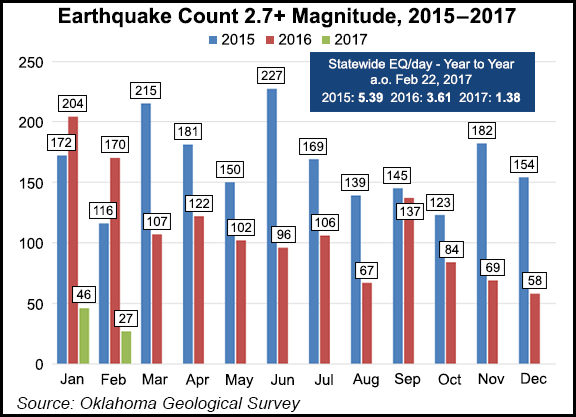E&P | NGI All News Access | Regulatory
Oklahoma Regulators Look to Limit Future Disposal Volume Increases
Regulators in Oklahoma said the number of earthquakes in the state has declined since they began issuing directives to reduce wastewater disposal volumes, but their latest directive aims to limit future volume increases.

In a letter to wastewater disposal well operators last week, the Oklahoma Corporation Commission (OCC) and its Oil and Gas Conservation Division (OGCD) said recent earthquake data compiled by the Oklahoma Geological Survey (OGS) constituted an “emergency situation.”
Under the latest directive, regulators made adjustments to the distribution of volume allotments issued in earlier directives, and set additional limits for wells within a 15,000-square mile area of interest (AOI) that were not included previously. OGCD said some of the wells covered are high-volume wells permitted to dispose of up to 100,000 b/d of wastewater.
“The continued drop in earthquakes, as well as new data and input from the OGS have caused a change in our orientation from focusing on current disposal volumes within the AOI to looking ahead to try and ensure there isn’t a sudden, surprise jump in those disposal volumes,” said OGCD Director Tim Baker.
OCC and OGCD have been trying to mitigate induced seismic activity across the state, especially from wastewater injection wells targeting the Arbuckle formation, for two years. Regulators have focused on operations in the Mississippian Lime and the Hunton Dewatering play, which lie within the AOI.
The latest directive affects 654 disposal wells in the AOI targeting the Arbuckle, and includes wells “that previously were not under a volume reduction directive because there has been no seismicity in their area,” Baker said. OGCD added that the directive will remove the potential for an increase in disposal volumes within the AOI by about 2 million b/d.
Specifically, Arbuckle disposal wells within the central part of the AOI — dubbed the Oklahoma Central Reduction Area (OCRA) by OGCD — not currently injecting at a rate higher than a 10,000 b/d rolling 30-day average will have a limit of the lesser of two figures: the 10,000 b/d rolling 30-day average, or the well’s permitted daily volume.
Arbuckle wells within OCRA currently injecting at a rate higher than a 10,000 b/d rolling 30-day average will have a limit of the higher of the last two 30-day averages, based on volumes reported to regulators. Operators using the cumulative volume method must choose the lesser figure for single day volumes: 5,000 b/d above the new 30-day average limit or the permitted daily volume.
Similar rules will apply in the western part of the AOI, which OGCD is calling the Oklahoma Western Reduction Area (OWRA), but with a rate of 15,000 b/d substituted for every aforementioned instance of 10,000 b/d. For all Arbuckle wells within the AOI, but not covered under a previous directive, the 15,000 b/d limits established for OWRA wells will apply.
“We have a few Arbuckle disposal wells in the AOI that without this directive could add more than 2 million b/d in disposal to the Arbuckle,” Baker said. “They are currently operating at a fraction of their permitted volume, and the new cap will be based on the much lower last 30-day average of their disposal volumes.
“Other wells are already operating under a reduction directive with volumes that are lower than even those allowed. We don’t want to see them jump drastically in one day, even if they are within their directive limits. So they will have a cap to limit how much they can increase volume at once.”
OGCD said it consulted with the OGS in developing the latest directive. The regulatory agency added that all previously issued directives, including those that called for specific cutbacks and shut-ins, remain in effect.
Baker called the latest directive a “data-driven” approach.
“The amount and quality of the data now available to us is far ahead of where we were a year ago,” he said. “We can make decisions on a much timelier basis. Given that, operators need to be aware that we will take action if that data indicates further volume reductions should be put in place. The earthquake rate is headed in the right direction, but this remains our most critical issue.”
According to the OGS, so far this year there have been 73 earthquakes in Oklahoma measuring 2.7-magnitude or higher. By comparison, there were 288 such earthquakes in the first two months of 2015, and 374 in 2016.
Last December, OGCD and OGS jointly promulgated new seismicity guidelines covering the Midcontinent reservoirs — specifically, the South Central Oklahoma Oil Province and the Sooner Trend of the Anadarko Basin in Canadian and Kingfisher counties — in anticipation of increased drilling there.
© 2024 Natural Gas Intelligence. All rights reserved.
ISSN © 2577-9877 | ISSN © 2158-8023 |
